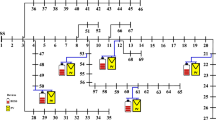Abstract
Renewable power generation sources used as distributed generations (DGs) are increasing rapidly all around the world. Apart from environmental advantages, DGs result in reduction of power losses, improvement of bus voltages, increased system reliability, stability, power quality and ease of operation. In this work, the impacts of DG on power losses, bus voltages and short circuit level of the power system are investigated with different case strategies of DG interconnections. With every strategic case, the DG impacts on power system are analyzed by network simulation through Power System Simulator Siemens Network Calculator software (PSS SINCAL). Significant power losses and voltage improvement were observed depending on size and strategic locations of DG interconnections. Slight increase in network short circuit levels is observed within permissible limits of protection devices. The communication prospects of DG and Smart Grid Integration are also discussed to enable the monitoring, control of interconnected DG units with a two-way electricity and information flow to develop an automated distributed energy network. Finally, an attempt is made to strategize a simple and gradually applicable model of controlling the network conditions through the integration of DGs. Using the state of art of DG integration models, the gradually implementable smart grid system is proposed for under developed countries, like Pakistan.















Similar content being viewed by others
References
Halepoto, I. A., Uqaili, M. A., & Chowdhry, B. S. (2014). Least square regression based integrated multi-parameteric demand modeling for short term load forecasting. Mehran University Research Journal of Engineering and Technology, 33(2), 215–226.
Awan, A. B., & Khan, Z. A. (2014). Recent progress in renewable energy—Remedy of energy crisis in Pakistan. Renewable and Sustainable Energy Reviews, 33, 236–253.
Harijan, K., Uqaili, M. A., & Memon, M. (2009). Renewable energy for managing energy crisis in Pakistan. In Wireless Networks, Information Processing and Systems (pp. 449–455). Springer, Berlin, Heidelberg.
Farooqui, S. Z. (2014). Prospects of renewables penetration in the energy mix of Pakistan. Renewable and Sustainable Energy Reviews, 29, 693–700.
Calderaro, V., Conio, G., Galdi, V., Massa, G., & Piccolo, A. (2014). Active management of renewable energy sources for maximizing power production. International Journal of Electrical Power and Energy Systems, 57, 64–72.
Poudineh, R., & Jamasb, T. (2014). Distributed generation, storage, demand response and energy efficiency as alternatives to grid capacity enhancement. Energy Policy, 67, 222–231.
Wei, M. Y. (2014). Impact of distributed generation on power system. Applied Mechanics and Materials, 543, 681–684.
Uqaili, M. A., Sahito, A. A., Halepoto, I. A., Memon, Z. A., & Dars, S. B. (2014). Impact of distributed generation on network short circuit level. In 4th International Conference on Wireless Communications, Vehicular Technology, Information Theory and Aerospace and Electronic Systems (VITAE), 2014, Aalborg Denmark (pp. 1–5) 11th–14th May, 2014.
Farhangi, H. (2014). A Road map to integration: Perspectives on smart grid development. Power and Energy Magazine, IEEE, 12(3), 52–66.
Ruiz-Romero, S., Colmenar-Santos, A., Mur-Pérez, F., & López-Rey, Á. (2014). Integration of distributed generation in the power distribution network: The need for smart grid control systems, communication and equipment for a smart city—Use cases. Renewable and Sustainable Energy Reviews, 38, 223–234.
Huber, M., Dimkova, D., & Hamacher, T. (2014). Integration of wind and solar power in Europe: Assessment of flexibility requirements. Energy, 69, 236–246.
Iqbal, M. A., & Sharma, S. (2014). Analysis and comparison of various control strategy of hybrid power generation a review. In IEEE 1st International Conference on Non-Conventional Energy (ICONCE) (pp. 184–189).
Lopes, J. A., Hatziargyriou, N., Mutale, J., Djapic, P., & Jenkins, N. (2007). Integrating distributed generation into electric power systems: A review of drivers, challenges and opportunities. Electric Power Systems Research, 77(9), 1189–1203.
Sahito, A. A., Uqaili, M. A., Larik, A. S., & Mahar, M. A. (2014). Nonlinear controller design for buck converter to minimize transient disturbances. Science International, 26(3), 1033–1037.
Barker, P. P., & de Mello, R. W. (2000). Determining the impact of distributed generation on power systems. I. Radial distribution systems. In IEEE Power Engineering Society Summer Meeting (pp. 1645–1656).
Hung, D. Q., Mithulananthan, N., & Lee, K. Y. (2014). Optimal placement of dispatchable and non dispatchable renewable DG units in distribution networks for minimizing energy loss. International Journal of Electrical Power and Energy Systems, 55, 179–186.
Farhana, U., Farhana, N. A., Sahito, A. A., & Pathan, A. Z. (2013). Critical analysis of capacitors as a potential solution to achieve optimum level voltage regulation in HESCO network. In IEEE International Conference on Technological Advances in Electrical, Electronics and Computer Engineering (TAEECE) (pp. 488–497).
Boutsika, T. N., & Papathanassiou, S. A. (2008). Short-circuit calculations in networks with distributed generation. Electric Power Systems Research, 78(7), 1181–1191.
Buccella, C., Cecati, C., & Abu-Rub, H. (2014). An overview on distributed generation and smart grid concepts and technologies. In H. Abu-Rub, M. Malinowski & K. Al-Haddad (Eds.), Power Electronics for Renewable Energy Systems, Transportation and Industrial Applications. Chichester, UK: Wiley.
Aamir, M., Uqaili, M. A., Amir, S., Chowdhry, B. S., Rafique, F., & Poncela, J. (2014). Framework for analysis of power system operation in smart cities. Wireless Personal Communications, 76(3), 399–408.
Acknowledgments
This work has been funded by ICT Endowment Fund, under sponsorship of Mehran University of Engineering and Technology (MUET), Jamshoro, Pakistan. The authors acknowledges the MUET, Jamshoro for providing the research facilities and extending the support to carry the research work.
Author information
Authors and Affiliations
Corresponding author
Rights and permissions
About this article
Cite this article
Sahito, A.A., Halepoto, I.A., Uqaili, M.A. et al. Analyzing the Impacts of Distributed Generation Integration on Distribution Network: A Corridor Towards Smart Grid Implementation in Pakistan. Wireless Pers Commun 85, 545–563 (2015). https://doi.org/10.1007/s11277-015-2754-y
Published:
Issue Date:
DOI: https://doi.org/10.1007/s11277-015-2754-y




